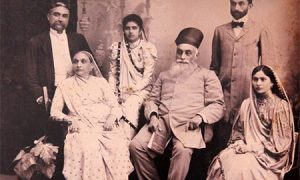The followers of other religions turned to Baha’ism via the emergence of Bahaism and the advertisements done by the disciples of Hussein Ali Nouri (Bahaullah). The Zoroastrians quitted their religion in 18th century A.D. and became
Baha’i adjusting their religion with the Zoroastrian teachings. Introducing Bahaullah as the savior and as a person whose consanguinity goes back to Zoroaster and Anoushirvan Sasani. However, investigating the conditions and specifications of the savior in Zoroastrian religion indicate that Bahaullah can’t be the promised one of the Zoroastrians. Also, there aren’t any time and place for Zoroaster definitely. Additionally, the kingdom case of Anoushirvan Sasani is not in such a manner which gaining relationship to this king will be honorable and glorious. Changing the Zoroastrians’ religion in this case caused the Zoroastrian teachers to debate with newly-Baha’i Zoroastrians concerning the topic of Bahaullah’s being the promised one.
Following this issue, the Bahaism influence among a part of the Iranian Zoroastrians community (the newly- Baha’is) was considered as one of the greatest problems of the followers of this religious minority during Qajar dynasty. During these days, some educated Zoroastrian youth affected by the life style and teachings of the Persian community of India turned to do social reforms and extensive religious ones among the Iranian Zoroastrian community influenced by reformist slogans and the slogans asking for equality in Bahaism. They formed a population called the population of the Iranian Zoroastrians who had become Baha’i (Ahebba). The achievement of researches indicate that the created social pressures on this group and supporting these people by Persian community of India and England caused for some parts of the Zoroastrians to turn to the newly-emerged creed of Baha ism. This issue ended in extensive conflicts among famous Zoroastrians in Iran.
Consequently, the main reason for turning some Iranian Zoroastrian to the Baha’ism cult must be searched in another factors. In this regard, it can be said that what mentioned about the tendency of the Jewish to Bahaism (the British government order) is true in minor scale about the Baha’i Zoroastrians. The wave of this tendency happened in 1919 A.D. during which nearly 250 Zoroastrian people became Baha’i. The servants of Lord Jamshid Jamshidian, the influential Zoroastrian rich man who were living in Hussein Abad village, Maryam Abad village, Qasem Abad village and etc. from Yazd and Kerman. Keykhosrow J. known as Reporter, one of the Zoroastrian migrants of India and of the pupils of Manekji who was serving in the foreign ministry of Britain. After Manekji’s death in 1276 S.H. in Tehran city, he continued his master’s mission by establishing Naseri association for the Zoroastrians of Yazd, Tehran and Kerman. Lord Jamshid was one of the most intimate friends of Ardeshir Reporter, the chairman of the intelligent service of Indian government (India) of Britain in Iran after Manekji Hatria to such an extent that some secret meetings between Ardeshir Reporter and Reza Khan were done in lord Jamshid’s house.
So, generally speaking, the reasons for joining some Iranian Zoroastrians to the deviant cult of Baha’ism are as follows:
۱) Social pressures on Zoroastrian thinkers through Persian community of India and British government.
۲) Supporting these people by the Persian community of India and England.
۳) The influence of the British intelligent service on the Iranian Zoroastrians by Manekji, Jamshid Jamshidiyan, the rich influential Zoroastrian which ended in his followers to be Baha’i.






